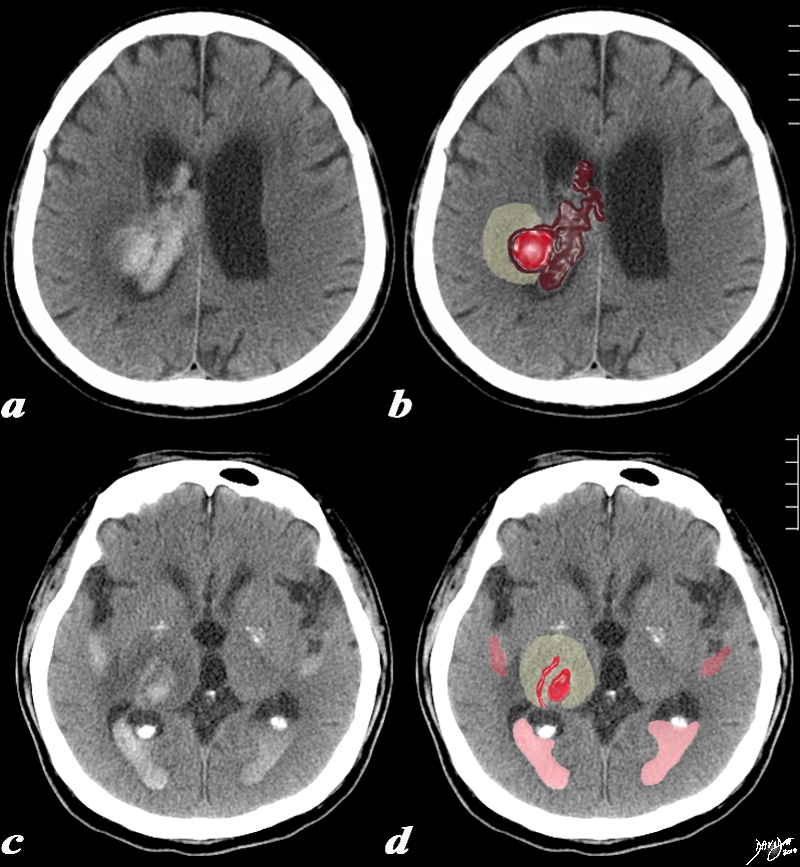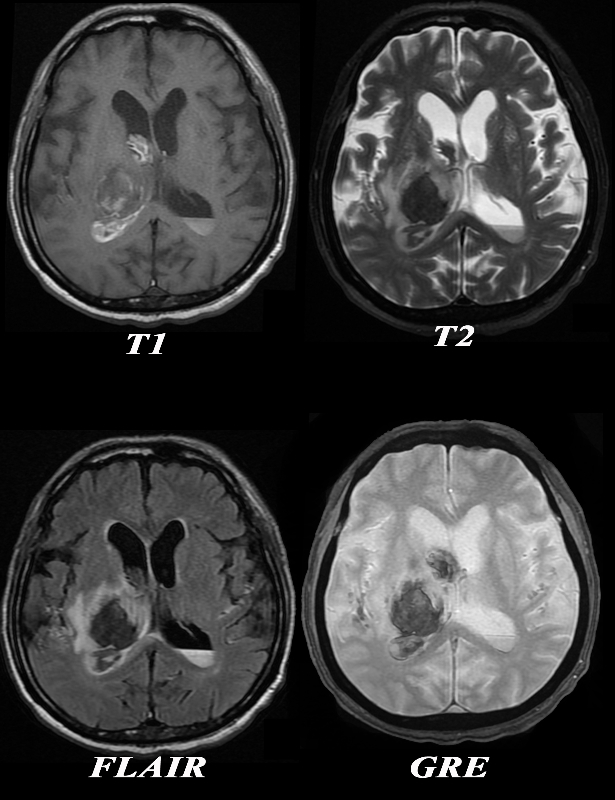Hyperacute Intracerebral hemorrhage
The Common Vein Copyright 2010
Introduction
CT

Acute Thalamic Hemorrhage |
|
The CT is from a 77year old male with acute neurological deficit The epicenter of the disease is an acute hemorrhage in the right thalamus, bright red in (b,d) with extension of the clot into the ventricle (maroon). There is non clotted blood lying dependently in the occipital horns (dense on c) presenting as a CSF-blood level (light pink on black CSF) in (d). The hemorrhage is surrounded by a rim of edema (light yellow) as seen in b and d. Courtesy Ashley Davidoff MD Copyright 2010 All rights reserved 90461c03.8s |
Aging the Hemorrhage on MRI
Hyperacute – minutes to hours
T1 – hematoma (deoxyHb) dark => isointense
T2 – hematoma (deoxyHb) dark=> isointense
Acute – 0-2 days
deoxyhemoglobin is in intact RBCs with surrounding edema
T1- hematoma isointense, edema dark
T2 – hematoma dark, edema bright
Subacute – 2-14 days
deoxyhemoglobin changes to methemoglobin from outer to inner
T1 – outer core bright
T2 – outer core bright due to shortened T1, longer T2
Chronic – 14 days
hemosiderin laden macrophages at periphery
T1 – inner core bright, rim dark
T2 – inner core bright, rim has low dark
Chronic – months later
hemosiderin laden macrophages at periphery
T1- mostly iso-/dark, rim is dark
T2- markedly dark rim – “blooms” with greater T2-weighting

Hyperacute Hemorrhage in the Right Thalamus |
|
The MRI is from a 77year old male with acute neurological deficit The epicenter of the disease is a hemorrhage in the right thalamus. The T1 weighted image (upper left) shows mostly hypointense signal indicating the presence of deoxyhemoglobin. On the T2 weighted image the signal of the hematoma is also mostly hypointense confirming the hyperacute nature of the hematoma, surrounded by a ring of increased signal reflecting edema. There is a layering effect of blood in the posterior horn on the left The presence of deoxyhemoglobin dates the hemorrhage between minutes to hours The FLAIR image (c) shows the hyperacute hematoma as hypointense and the surrounding edema as hyperintense. The GRE image fails to reveal hemosiderin deposit in the periphery making chronic hemorrhage unlikely. The diagnosis of hyperacute intracerebral hemorrhage (minutes to hours) is therefore made by the presence of deoxyhemoglobin hypo/isointensity on the T1 weighted images and the hypointensity on T2 weighted. The suurounding edema is best seen on the T2 and FLAIR images. The extension into the ventricles is apparent on all sequences. Courtesy Ashley Davidoff MD Copyright 2010 All rights reserved 90484c04.8 |
